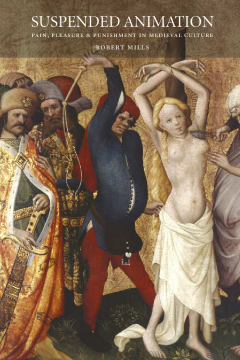
Additional Information
Book Details
Abstract
When Marsellus in the film PulpFiction asserts, "I'm gonna git medieval on your ass," we know that he is about to bring down a fierce and exacting punishment. Yet is the violence of the Middle Ages that far removed from our modern society? Suspended Animation argues that not only is the stereotype of uncontrolled violence in the Middle Ages historically misleading, the gulf between modern society and the medieval era is not as immense as we might think. In fact, both medievals and moderns live within a social tension of "suspended animation" engendered by images and acts of violence.
Just as in medieval times, Robert Mills argues, it is the threat of violence—not the reality—that continues to structure our lives. To illustrate this "aesthetics of suspense," Mills draws on extensive and disturbing examples from medieval iconography, contemporary philosophy, and even pornography, ranging from the vivid depictions of Hell in Tuscan frescoes to Billie Holiday's famously wrenching song "Strange Fruit". Mills reveals how these uncomfortable images and texts expose a modern self-deception, and he further explores how medieval images evoked a pleasure revealingly close to that found in modern depictions of sexuality. Suspended Animation also makes a fresh contribution to theoretical debates on pre-modern gender and sexuality. Mills's comprehensive analysis demonstrates that—as wartime prisoner abuse incidents at Abu Ghraib and Guantánamo Bay have recently indicated—our notions of ourselves as not-medieval (that is, civilized) not only fail to prepare us for modern torture and warfare but also lead us into complicity with self-proclaimed moral and civic leaders.
Whether considering a medieval painting of a Christian martyr or the immense popularity of grotesque historical tourist attractions such as the London Dungeons, Suspended Animation argues that images of death and violence are as pervasive today as they were in the Middle Ages, serving as potent reminders of the link between the modern and the medieval era.
“With Suspended Animation, Robert Mills is out to rattle the discursive cages of medieval studies, drawing upon a dazzling array of primary sources both visual and textual and synthesizing the best recent research and theory.”--Mitchell B. Merback, author of The Thief, the Cross, and the Wheel
— Mitchell Merback
"Provocative. . . . His very attempts at new interpretations are what make this book a useful addition to scholars who study the cultural construct of pain. . . . This book makes extraordinary use of a wide range of primary sources, while competently synthesizing an extensive number of theoretical approaches. . . . The book reads as a cohesive whole, returning to and reevaluating the theme of temporal and visual suspense in an engaging manner that questions traditional assumptions about the medieval and modern understanding of pain. Indeed, it is Mills' very attempts at pushing the discursive limits of pain that makes this volume a valuable tool for medieval and modern literary critics, art historians, and historians alike."
— Scott E. Pincikowski, Medieval Review
"Surveys an impressive range of visual, literary and theoretical material. Perhaps, because of its sensitive subject matter, this is, nevertheless, an exceptionally careful, tentative and nuanced book. . . . This gorgeous and learned book leaves the reader both stimulated and animated."
— Times Literary Supplement"A provocative and insightful meditation on human pain as a shared obsession in medieval and modern culture. . . . Mills writes as clearly as he thinks (the prose descriptions of the images that he examines are a special delight to read) and the one hundred color and halftone plates are finely reproduced. . . . A fascinating and utterly credible protrayal of medieval culture."
— Comitatus: A Journal of Medieval and Renaissance Studies"Mills' book takes us into disturbing territory, but territory that needs investigation."
— Group AnalysisRobert Mills is lecturer in the Department of English Language and Literature at King's College, London, and coeditor of The Monstrous Middle Ages and Troubled Vision: Gender, Sexuality and Sight in Medieval Text and Image.
